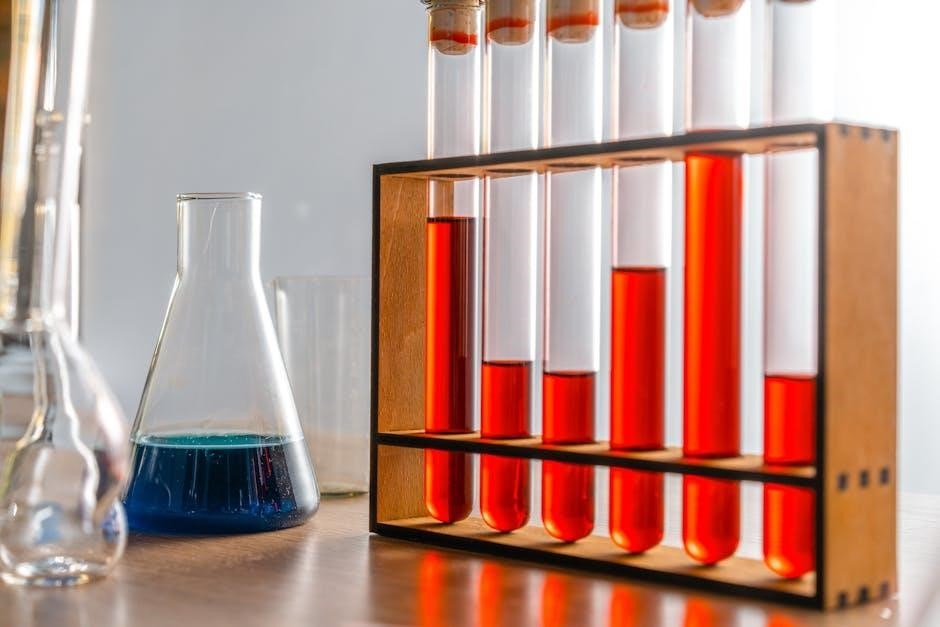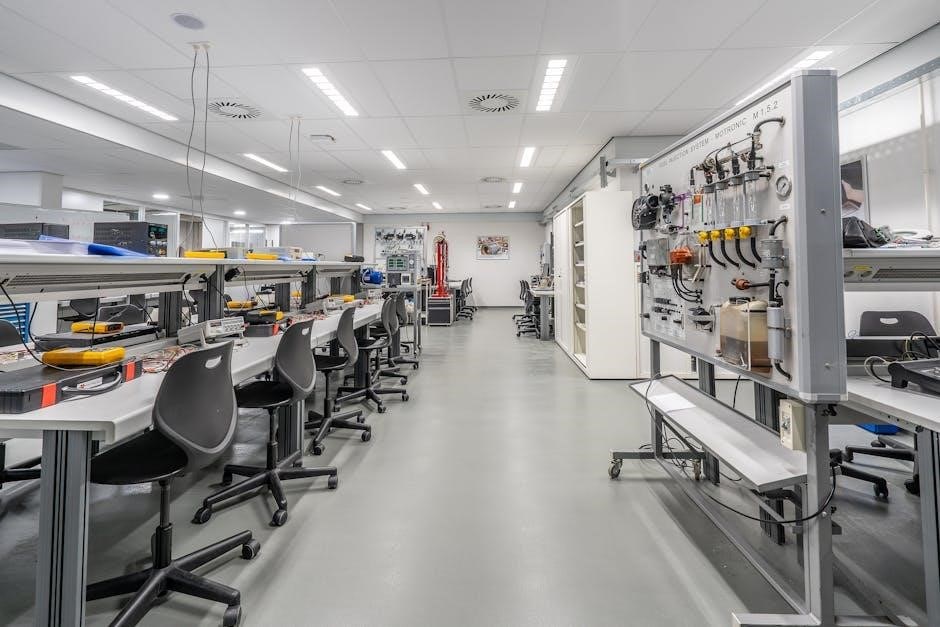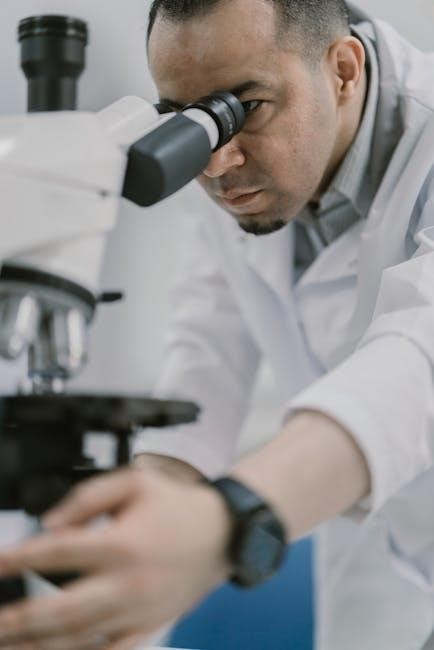surgical tech instruments study guide
Surgical Technology focuses on the safe and efficient use of instrumentation in healthcare settings, ensuring optimal patient outcomes during procedures. It involves precision instruments, proper handling techniques, and a deep understanding of their roles in surgery.
This study guide introduces key concepts, including instrument classification, handling protocols, and sterilization methods. It serves as a foundational resource for understanding the critical role of surgical instruments in modern healthcare.
1.1 Overview of Surgical Technology
Surgical Technology involves the use of specialized instruments and equipment to facilitate surgical procedures. It focuses on maintaining a sterile environment, ensuring instrument functionality, and supporting surgical teams. This field requires precision, attention to detail, and a strong understanding of medical protocols to ensure patient safety and optimal outcomes during operations.
1.2 Importance of Surgical Instruments in Healthcare
Surgical instruments are essential for enabling precise and safe surgical procedures. They allow healthcare professionals to perform complex operations with accuracy, ensuring optimal patient outcomes. Proper handling and maintenance of these tools are critical to preventing infections and complications.
The role of surgical instruments extends beyond procedure execution; they are vital for patient safety, efficiency, and the success of modern surgical practices. Their design and functionality continue to evolve, contributing significantly to advancements in healthcare and surgical technology.

Basic Surgical Instrument Classification
Surgical instruments are categorized into types based on their function and design, such as cutting, grasping, retracting, and suturing tools. This classification aids in organization and effective use during procedures.
2.1 Cutting Instruments
Cutting instruments are essential in surgery for making precise incisions or dividing tissues. They include scalpels, surgical knives, and dissecting scissors. These tools are designed for sharp, controlled cuts, ensuring minimal tissue damage and promoting effective surgical outcomes. Proper handling and maintenance are crucial for their longevity and performance.
2.2 Grasping and Holding Instruments
Grasping and holding instruments, such as forceps and clamps, are used to securely hold tissues or objects during surgery. They allow precise control, reducing tissue damage. These tools are crucial for maintaining clear surgical sites and ensuring efficient procedures. Proper selection and handling are vital for optimal surgical outcomes.
2.3 Retracting Instruments
Retracting instruments, such as retractors, are used to expose surgical sites by gently pulling back tissues. They come in various types, including Deaver, Weitlaner, and Bookwalter retractors, each designed for specific procedures. These tools are essential for maintaining clear visibility and access during surgery.
Proper selection and handling of retractors ensure minimal tissue trauma and optimal exposure, aiding surgeons in performing precise dissections. Surgical technologists must anticipate the need for retractors to maintain surgical efficiency and patient safety.
2.4 Suturing Instruments
Suturing instruments, such as needle holders and tissue forceps, are essential for closing wounds and joining tissues. Needle holders are used to grasp and maneuver sutures, while forceps assist in gripping tissue. These tools are typically made of stainless steel or titanium for durability.
Proper handling involves ensuring instruments are sterilized and maintained to prevent corrosion. Surgical technologists must select the appropriate size and type of suturing instruments based on the procedure and tissue type to facilitate precise suturing by surgeons.

Handling and Care of Surgical Instruments
Proper handling involves using gloves to prevent damage and maintain sterility. Instruments should be cleaned with mild detergents, avoiding harsh chemicals, and sterilized using autoclaves. Regular maintenance and organized storage in dry compartments ensure longevity and readiness for use.
3.1 Proper Handling Techniques
Always handle surgical instruments with clean, gloved hands to prevent damage and maintain sterility. Avoid using excessive force, which can bend or break delicate tools. Instruments should be kept dry and free from contaminants to ensure proper function during procedures.
Use soft, lint-free materials for wiping and storing instruments. Organize them neatly in trays or cases to prevent scratching and facilitate easy access during surgeries. Proper handling techniques are essential for extending the lifespan of surgical instruments.
3.2 Cleaning and Sterilization Methods
Cleaning and sterilizing surgical instruments are critical to prevent infection and ensure patient safety. Use ultrasonic cleaners for intricate tools and autoclaves for steam sterilization. Manual cleaning with enzymatic solutions is essential for removing organic matter before sterilization.
Always rinse thoroughly and dry instruments to prevent corrosion. Proper sterilization methods ensure instruments remain contamination-free and ready for use in surgical procedures, maintaining high standards of patient care and safety.
3.4 Maintenance and Storage Best Practices
Regularly inspect instruments for wear and tear, lubricate moving parts, and store them in protective cases to prevent damage. Avoid exposing instruments to corrosive environments or extreme temperatures, which can degrade materials and affect performance.
Store instruments in organized, dry spaces, and use inventory systems to track maintenance schedules. Proper storage ensures longevity, functionality, and readiness for surgical procedures, maintaining high standards of patient care and operational efficiency.
Safety Protocols in the Operating Room
Safety protocols ensure a secure environment for patients and staff, focusing on infection control, proper handling of sharps, and emergency preparedness. Adhering to these guidelines minimizes risks and maintains operational efficiency.
Strict adherence to sterilization, traffic control, and communication protocols is essential to prevent complications and ensure optimal surgical outcomes in the OR.
4.1 Infection Control Measures
Infection control measures are critical in surgical settings to prevent contamination and ensure patient safety. Proper sterilization of instruments, use of personal protective equipment, and strict hand hygiene protocols are essential.
Traffic control in the OR, limiting unnecessary entries, and maintaining a sterile field are key strategies to minimize infection risks during procedures.
4.2 Safe Handling of Sharp Instruments
Safely handling sharp instruments is vital to prevent injuries and maintain a secure environment. Using neutral zones for passing instruments and employing safety devices, like needle holders, reduces risks. Proper storage and disposal of sharps in designated containers are also critical measures.
Counting instruments before, during, and after procedures ensures none are left inside patients, enhancing safety and accountability.
4.3 Emergency Procedures in the OR
Emergency procedures in the OR require swift action to ensure patient safety. Protocols include fire safety measures, evacuation routes, and communication strategies. Surgical technologists must remain calm, follow established guidelines, and assist the surgical team effectively during unexpected situations.
Preparedness and clear communication are critical to managing emergencies efficiently, minimizing risks, and maintaining a sterile environment.

Surgical Technologist’s Role During Procedures
Surgical technologists play a vital role in ensuring smooth procedure execution. They prepare the surgical environment, maintain instrument counts, and anticipate the surgeon’s needs to optimize efficiency.
Their expertise in handling instruments and maintaining sterility is crucial for patient safety and successful surgical outcomes.
5.1 Preparing the Surgical Environment
Preparing the surgical environment involves setting up the operating room, arranging instruments, and ensuring all equipment is functional and sterile. This step is critical for maintaining a safe and efficient workspace.
The surgical technologist ensures the room is organized, supplies are within reach, and a sterile field is created to minimize contamination risks during procedures.
5.2 Anticipating the Surgeon’s Needs
Anticipating the surgeon’s needs requires careful observation of their preferences and surgical techniques. Surgical technologists must stay proactive, preparing instruments and supplies in advance based on the procedure’s progression.

This ensures a smooth workflow, allowing the surgeon to focus on the procedure without interruptions. It also involves maintaining a clean and efficient environment, ready to handle any unexpected requirements.
By staying attentive and anticipating next steps, surgical technologists play a vital role in supporting the surgical team and ensuring patient safety.
5.3 Managing Surgical Instrument Counts
Accurate instrument counts are critical to ensure patient safety and procedural efficiency. Surgical technologists must meticulously count instruments before, during, and after procedures to prevent loss or misuse.
This process involves verifying totals, tracking sharp instruments, and documenting findings. Effective counting practices minimize risks and maintain a sterile, organized surgical environment throughout the operation.

Instrument Sets and Trays
Surgical instrument sets and trays are organized collections of tools tailored for specific procedures, ensuring efficiency in the operating room. They simplify instrument preparation and access during surgeries.
6.1 General Surgery Instrument Sets
General surgery instrument sets are versatile collections of tools used in a wide range of procedures. They include scalpels, forceps, retractors, and suction tubes, providing essential instruments for common surgical tasks. These sets are designed to be efficient and accessible, allowing surgical technologists to prepare for various procedures effectively.
6.2 Specialty-Specific Instrument Trays
Specialty-specific instrument trays are customized for particular surgical disciplines, such as cardiothoracic, neurosurgery, or orthopedic procedures. These trays include instruments tailored to the unique demands of each specialty, ensuring precision and efficiency. They often feature specialized tools, like bypass clamps or bone rongeurs, designed for specific tasks, enhancing surgical outcomes and reducing setup time.
6.3 Organizing Instruments for Efficiency
Efficient organization of surgical instruments is crucial for seamless operations. Instruments are grouped by function, stored in labeled trays, and arranged in logical sequences. This systematic approach ensures quick access during procedures, reduces setup time, and minimizes errors, contributing to a more efficient and safe surgical environment.
Advanced Surgical Instrumentation
Advanced surgical instrumentation integrates cutting-edge technology to enhance precision and efficiency in modern surgeries. Robotic systems and minimally invasive tools are revolutionizing surgical practices, enabling complex procedures with greater accuracy and reduced patient recovery times.
These innovations are transforming the field, offering surgeons improved control and patients better outcomes, making advanced instrumentation indispensable in contemporary surgical care.
7.1 Robotic-Assisted Surgical Instruments
Robotic-assisted surgical instruments enhance precision and dexterity in minimally invasive procedures. These systems provide high-definition visualization and ergonomic design, enabling surgeons to perform complex tasks with greater accuracy and control.
Used in specialties like urology and gynecology, robotic instruments reduce human error, minimizing complications and recovery times, making them a cornerstone of modern surgical advancements.
7.2 Minimally Invasive Surgical Tools
Minimally invasive surgical tools enable smaller incisions, reducing tissue damage and recovery time. These instruments, such as laparoscopic and endoscopic tools, feature slim designs and precise tips, facilitating procedures with minimal patient discomfort.
They are integral to modern surgical advancements, improving outcomes and patient care.
7.3 Emerging Technologies in Surgical Tech
Emerging technologies in surgical tech, such as robotic-assisted systems and advanced imaging tools, enhance precision and minimize invasiveness. These innovations integrate AI for predictive analytics, improving decision-making. They also enable real-time data integration, streamlining procedures and enhancing patient outcomes.
Such advancements are revolutionizing healthcare, offering safer and more efficient surgical solutions.
Surgical Instrument Standards and Guidelines
Surgical instrument standards ensure safety, efficiency, and consistency in healthcare. These guidelines, set by organizations like ASTM and ISO, regulate instrument design, materials, and sterilization processes.
Adhering to these standards is critical for maintaining patient safety and operational excellence in surgical environments.

8.1 Industry Standards for Instrument Use
Industry standards for surgical instrument use are established by organizations like ASTM and ISO, ensuring safety, quality, and consistency. These standards regulate instrument design, materials, sterilization, and maintenance, promoting effective infection control and operational efficiency in healthcare settings.
- ASTM standards focus on material specifications and performance criteria.
- ISO standards ensure global harmonization in instrument design and safety.
Adhering to these standards is vital for maintaining patient safety and operational excellence.
8.2 Regulatory Compliance in Surgical Tech
Regulatory compliance in surgical technology ensures adherence to laws and guidelines set by bodies like the FDA and OSHA. These regulations cover instrument safety, sterilization protocols, and infection control, ensuring that practices align with legal and ethical standards to protect patients and healthcare workers effectively.
8.3 Best Practices for Instrument Handling
Proper handling of surgical instruments ensures safety, longevity, and sterility. Always use gloves, handle instruments by the designated areas, and avoid excessive force. Maintain sterility by keeping instruments organized and within the sterile field. Regular cleaning and inspection are crucial to prevent damage and ensure functionality during procedures.
Continuing Education and Professional Development
Continuing education is vital for surgical technologists to stay updated on advancements and guidelines. Lifelong learning, certification maintenance, and networking ensure professional growth and expertise in surgical instrumentation.
9.1 Recommended Textbooks and Resources
Key textbooks include “Surgical Technology for the Surgical Technologist” and “Essentials of Surgical Technology.” Online resources like AST and NBSTSA provide guides for certification and practice. These materials cover instrumentation, protocols, and advancements, ensuring comprehensive knowledge for surgical tech professionals.
9;2 Online Courses for Surgical Technologists
Online courses from platforms like Coursera, Udemy, and specialized surgical tech sites offer flexible learning. These courses cover instrument identification, surgical protocols, and patient safety. Many programs are self-paced, allowing professionals to enhance their skills conveniently. They often include interactive modules and real-world case studies for practical understanding.
9.3 Certification and Recertification Processes
Certification for surgical technologists is typically administered by the National Board for Surgical Technology and Surgical Assisting (NBSTSA). The exam assesses knowledge and skills in surgical instrumentation, patient safety, and procedural protocols. Recertification is required every 4 years through continuing education or additional exams to stay updated with advancing surgical technologies and standards.
This guide provides a comprehensive overview of surgical instruments, emphasizing their importance in modern healthcare. Continuous learning and adaptation to advancing technologies are essential for surgical technologists to excel in their roles.
10.1 Summarizing Key Concepts
Surgical technology revolves around precision instruments, proper handling, and sterilization. Key concepts include instrument classification, safety protocols, and the technologist’s role in maintaining sterility and efficiency during procedures. Understanding these principles ensures optimal patient care and successful surgical outcomes, while staying updated on advancements in surgical instrumentation is crucial for professionals.

10.2 Encouragement for Lifelong Learning
Embrace lifelong learning to stay updated on surgical technology advancements. Pursue certifications, attend workshops, and explore online courses to enhance your skills. Engage with professional communities and seek mentorship to adapt to evolving patient needs and technological innovations. Continuous learning ensures professional growth and improved patient outcomes in surgical settings.
